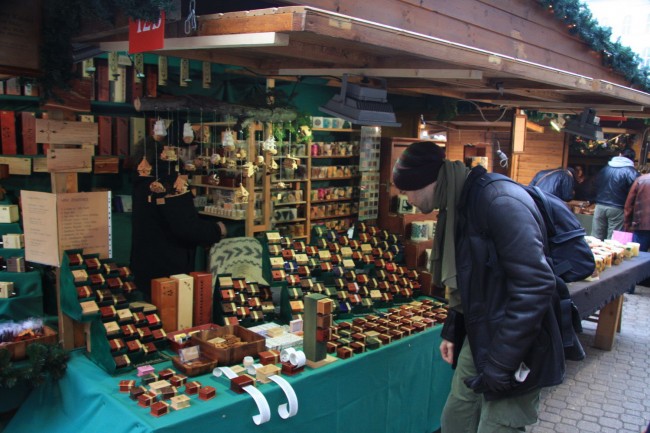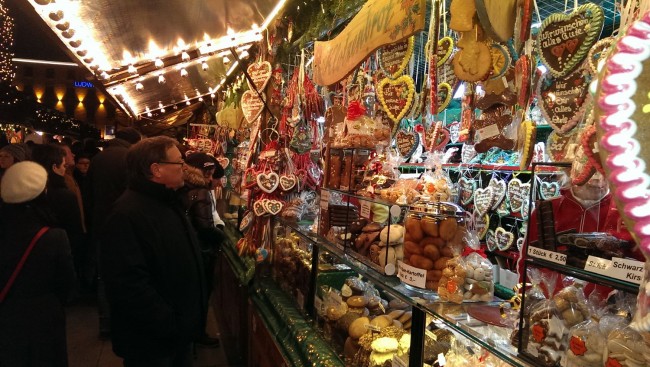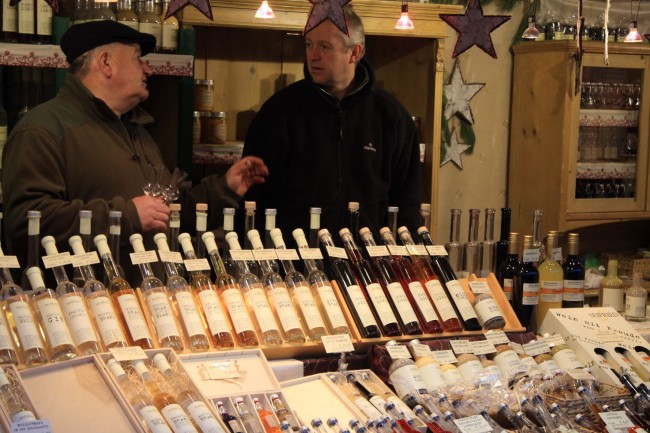After years of talking about Christmas in Europe we finally did it! Our son Jonathan graduates from College soon and before he heads out on his own worldly adventures, we decided to take our 2013 family vacation in central Europe. On the itinerary were Munich, Budapest, Vienna and Salzburg.
Landing at Munich Airport and not even out of the airport terminal, we encounter our first Christmas Market which occupies space in the plaza dividing the airport’s two terminals. Munich has approximately 20 Christmas markets, each with its own theme. We visited three, located at Munchener Freiheit, Odenplatz and Marienplatz.
Marienplatz, the largest and probably best known of Munich’s Christmas markets, is located in front of the Neues Rathaus (New City Hall, built in 1908) in the heart of the city’s historic district within a short walking distance of several historic churches, a royal palace, museums, high-end shops, restaurants and, yes, beer halls.
Bustling with shoppers and revellers enjoying Bavarian Weisswurst, bratwurst and Gluhwein, Marienplatz features brightly decorated vendors’ stalls stocked with only hand-made Christmas ornaments and gifts of the highest quality. Not everyone can get a license to sell at these markets. One vendor told us that it took her and her husband nine years to get into the Marienplatz market and an additional three years to obtain a prime location. Not only is it location, location, location at these markets, but it is also quality, quality, quality.
Christmas markets in Budapest are different from the ones in Germany and Austria in that they sell a wider range of gifts and not everything is hand-made, which provides for a greater range of wares to pick from and can make browsing more interesting. But if purely hand-made gifts captivate you then stick to the German-speaking regions of Europe.

Jonathan picking out a miniature, wooden music box at the Deak Ferenc Street Christmas Market, Budapest.
There are a few small Christmas markets on the Buda side on Gellert Hill and Castle Hill. These markets are worth seeing only if you happen to be sightseeing in the area since the best markets are in Pest. We love iron-work so we were ecstatic to find two blacksmiths working a traditional forge, hammering out red-hot iron to craft decorations and personalized gifts at St Stephen’s Basilica Christmas Market.
The largest Pest market is located in the Deak Ferenc Utca street district behind the Kempinski Hotel. While the gifts are the main attraction, the food is amazing, with lane after lane of food vendors’ stalls selling a wide variety of traditional Hungarian food, all freshly prepared and cooked over wood-fired stoves. Vegans should note that this is a carnivore friendly zone.
Arriving in Vienna on Christmas day we find some Christmas markets that are still open and will remain so until New Years Eve. At Maria-Théresien-Platz the market is still vibrant with specialty handcrafted items such as pottery, jewellery, woodcrafts and toys for sale. One of the stalls sells the original Perzy Snow Globe, invented in Vienna in 1900 by Erwin Perzy and still handcrafted here.
We next visit a Christmas market located in the central outdoor courtyard of the stunning Schonbrunn Palace. If you were still looking for that one-of-a-kind gift you would find it here, as the selection is as unique and artistically unusual as you would ever hope to find. We have just enough time to browse this market before we tour the Palace and before we prepare for an evening concert at l’Orangery, Schonbrunn’s former imperial greenhouse, made famous as the venue of Mozart’s first operatic concert. Tonight we enjoy his brilliant music along with that of Beethoven and the lighter Strauss waltzes before we have to say goodbye to Vienna and hello to Salzburg.
Salzburg, Mozart’s birth-place, is a must-see for anyone interested in his music. Dominating Salzburg from high above is Hohensalzburg Castle where we spend the glorious, sun-drenched morning of December 31st on its ramparts gazing upon the historic city below as well as taking in the magnificent views of the snow-capped Austrian Alps in the distance. On our descent from the fortress and walking past St. Peter’s Church, we found ourselves in the midst of a Christmas market turned New Year’s market, one that tempted both sight and smell. We not only found many styles of the “lucky pink pig,” so popular here for New Year’s Eve, but also many varieties of foods from rustic breads, potato salads and hearty meat dishes to sweet cakes, strudels and many kinds of pastries and freshly cut flowers.

Completing the firing of the 4:00 p.m. cannon officially starting New Years Eve celebrations in Salzburg, with the Hohensalzburg Castle high on top of the hill in the background from where fireworks will ring in 2014.
Italians love to spend New Year’s Eve in Salzburg, and who can blame them? The city is stunningly beautiful. The celebrations start at 4:00 p.m., when the city’s main bridge is closed to vehicles and an 18th century cannon fires a salute from the bridge. In response, and from all directions, artillery salutes are fired in return from ancient batteries high above the city. At midnight the fireworks display at Hohensalzburg Castle rings in 2014.
Written by Joseph and Diane Frey
Photo Credits
So many baked goods, so little time by Jonathan Frey – All Rights Reserved
Deak Ferenc Street Christmas Market by Joseph Frey – All Rights Reserved
New Years Market, Vienna by Joseph Frey – All Rights Reserved
New Years Eve celebrations in Salzburg by Jonathan Frey – All Rights Reserved




Excellent article!
If you would like to find out more about Budapest, visit our blog: https://www.stagkissbudapest.com/blog/
Joe, your article makes me want to put Yule-time in Europe on my bucket list. We need to think outside the box in terms of tradtional travel times to the continent to savour the best of what it offers!
This is the second time that we have spent Christmas and New Years in Europe. The continent provides a more traditional Christmas experience and a more sophisticated New Years Eve.